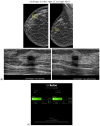New Frontiers in Breast Cancer Imaging: The Rise of AI
- PMID: 38790318
- PMCID: PMC11117903
- DOI: 10.3390/bioengineering11050451
New Frontiers in Breast Cancer Imaging: The Rise of AI
Abstract
Artificial intelligence (AI) has been implemented in multiple fields of medicine to assist in the diagnosis and treatment of patients. AI implementation in radiology, more specifically for breast imaging, has advanced considerably. Breast cancer is one of the most important causes of cancer mortality among women, and there has been increased attention towards creating more efficacious methods for breast cancer detection utilizing AI to improve radiologist accuracy and efficiency to meet the increasing demand of our patients. AI can be applied to imaging studies to improve image quality, increase interpretation accuracy, and improve time efficiency and cost efficiency. AI applied to mammography, ultrasound, and MRI allows for improved cancer detection and diagnosis while decreasing intra- and interobserver variability. The synergistic effect between a radiologist and AI has the potential to improve patient care in underserved populations with the intention of providing quality and equitable care for all. Additionally, AI has allowed for improved risk stratification. Further, AI application can have treatment implications as well by identifying upstage risk of ductal carcinoma in situ (DCIS) to invasive carcinoma and by better predicting individualized patient response to neoadjuvant chemotherapy. AI has potential for advancement in pre-operative 3-dimensional models of the breast as well as improved viability of reconstructive grafts.
Keywords: CNN; MRI; artificial intelligence; breast cancer; deep learning; mammography; risk stratification; ultrasound.
Conflict of interest statement
LRM—Medical Advisory Board ScreenPoint Medical.
Figures







References
-
- Society A.C. Breast Cancer Facts & Figures 2022–2024. American Cancer Society, Inc.; Atlanta, GA, USA: 2022.
Publication types
LinkOut - more resources
Full Text Sources

